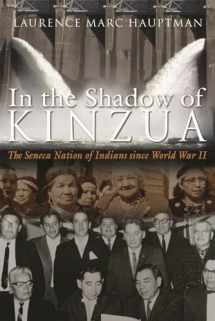
In the Shadow of Kinzua: The Seneca Nation of Indians since World War II (The Iroquois and Their Neighbors)
ISBN-13:
9780815634621
ISBN-10:
0815634625
Edition:
Reprint
Author:
Laurence M. Hauptman
Publication date:
2016
Publisher:
Syracuse University Press
Format:
Paperback
456 pages
Category:
Native American
,
Americas History
,
State & Local
,
United States History
FREE US shipping
Book details
ISBN-13:
9780815634621
ISBN-10:
0815634625
Edition:
Reprint
Author:
Laurence M. Hauptman
Publication date:
2016
Publisher:
Syracuse University Press
Format:
Paperback
456 pages
Category:
Native American
,
Americas History
,
State & Local
,
United States History
Summary
In the Shadow of Kinzua: The Seneca Nation of Indians since World War II (The Iroquois and Their Neighbors) (ISBN-13: 9780815634621 and ISBN-10: 0815634625), written by authors
Laurence M. Hauptman, was published by Syracuse University Press in 2016.
With an overall rating of 4.2 stars, it's a notable title among other
Native American
(Americas History, State & Local, United States History) books. You can easily purchase or rent In the Shadow of Kinzua: The Seneca Nation of Indians since World War II (The Iroquois and Their Neighbors) (Paperback) from BooksRun,
along with many other new and used
Native American
books
and textbooks.
And, if you're looking to sell your copy, our current buyback offer is $2.75.
Description
2014 Award of Merit winner from the American Association for State and Local HistoryThe Kinzua Dam has cast a long shadow on Seneca life since World War II. The project, formally dedicated in 1966, broke the Treaty of Canandaigua of 1794, flooded approximately 10,000 acres of Seneca lands in New York and Pennsylvania, and forced the relocation of hundreds of tribal members. Hauptman offers both a policy study, detailing how and why Washington, Harrisburg, and Albany came up with the idea to build the dam, and a community study of the Seneca Nation in the postwar era. Although the dam was presented to the Senecas as a flood control project, Hauptman persuasively argues that the primary reasons were the push for private hydroelectric development in Pennsylvania and state transportation and park development in New York.This important investigation, based on forty years of archival research as well as on numerous interviews with Senecas, shows that these historically resilient Native peoples adapted in the face of this disaster. Unlike previous studies, In the Shadow of Kinzua highlights the federated nature of Seneca Nation government, one held together in spite of great diversity of opinions and intense politics. In the Kinzua crisis and its aftermath, several Senecas stood out for their heroism and devotion to rebuilding their nation for tribal survival. They left legacies in many areas, including two community centers, a modern health delivery system, two libraries, and a museum. Money allocated in a “compensation bill” passed by Congress in 1964 produced a generation of college-educated Senecas, some of whom now work in tribal government, making major contributions to the Nation’s present and future. Facing impossible odds and hidden forces, they motivated a cadre of volunteers to help rebuild devastated lands. Although their strategies did not stop the dam’s construction, they laid the groundwork for a tribal governing structure and for managing other issues that followed from the 1980s to the present, including land claims litigation and casinos.


We would LOVE it if you could help us and other readers by reviewing the book
Book review

Congratulations! We have received your book review.
{user}
{createdAt}
by {truncated_author}




